EXHIBITOR Magazine Announces Expo 2012 Award Winners

For more than 25 years, EXHIBITOR has brought you the world’s most prestigious exhibit-design competition, honoring the crème de la crème of trade show exhibits. And in 2010, EXHIBITOR honored some of the most impressive temporary experiential structures the world has ever seen with its Expo 2010 Awards. Expanding on the success of that program, EXHIBITOR launched its Expo 2012 Awards three months ago, and is finally ready to announce the winners and honorable mentions in the competition’s nine categories.
The purpose of the competition was to honor the most impressive work from the 2012 World’s Expo in Yeosu, South Korea, and to spotlight some of the incredible pavilions there, all brimming with inspiration for exhibit and event professionals.
The competition netted entries from dozens of country, corporate, and theme pavilions, ranging from Turkey and Thailand to Switzerland and Singapore. Reflecting the Expo’s theme of “The Living Ocean and Coast,” many of the pavilions focused on environmental issues such as marine biodiversity, climate change, and environmental sustainability.
While a star-studded panel of multidisciplinary design, marketing, and communications experts judged seven categories, the People’s Choice Award winner was determined by popular vote on EXHIBITOR’s Expo 2012 microsite, and the editor of EXHIBITOR magazine determined the winner of our Editor’s Choice Award.
“The Expo 2012 Award winners and honorable mentions represent some of the world’s best examples of how experiential design, technology, presentation, and storytelling come together to effectively communicate compelling messages,” said Travis Stanton, editor of EXHIBITOR magazine. “These examples will hopefully inform and inspire today’s exhibit and event professionals — along with the next generation of face-to-face marketers. Because whether you’re creating an immense international pavilion or a small 10-by-10-foot exhibit, it’s often about making an impression, and the work on display in Yeosu does that in truly monumental and memorable ways.”
So join us in congratulating EXHIBITOR Magazine’s Expo 2012 Award winners (listed below). After all, according to our judges, our readers, and, well, ourselves, they are among the best the world (well, the World’s Expo, at least) has to offer.
For more information on the winners of EXHIBITOR Magazine’s Expo 2012 Awards, watch for the December 2012 issue of EXHIBITOR magazine.
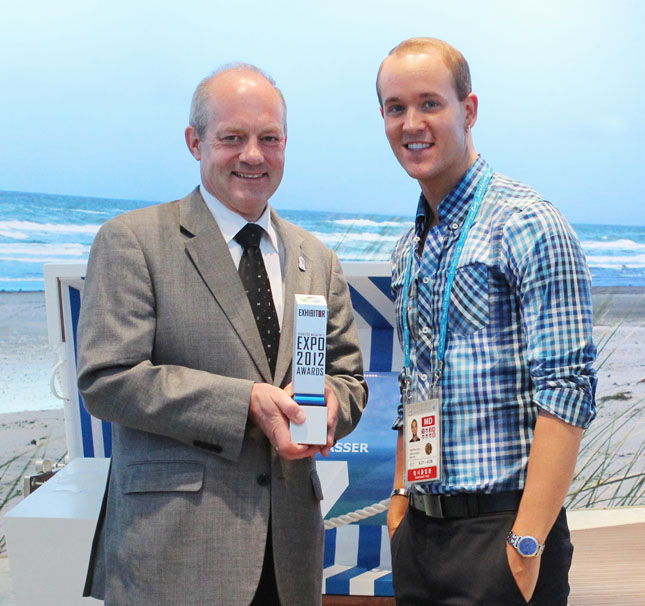 BEST PAVILION
Winner:
BEST PAVILION
Winner: Germany Pavilion
Client: Federal Ministry of Economics and Technology, Germany
Design: Arge Expo 2012: Facts and Fiction GmbH, GTP Architekten
Fabrication: Holtmann GmbH + Co. KG
The Germans do many things well — build cars, invade France, and create pavilions of extraordinary design and unusual inventiveness. In awarding Germany the Expo 2012 Award for Best Pavilion, judges raved about “The engaging activities that combined humanistic and high-tech elements to explore the oceans in detail.”
After a pre-show film on Germany’s North Sea and Baltic Sea coastlines concluded, sections of the projection screen rotated to reveal several gates. Attendees passed through those gates into a beach-inspired landscape whose lifelike illusion was created by giant seaside wall graphics. Pictures of real beaches were also printed on carpeting with extra-plush padding that replicated the feeling of sand under visitors’ feet. Kiosks embedded into beach chairs were arranged over the synthetic sand and supplied interactive animations related to the oceans and coasts.
Attendees learned how the ocean is the largest ecosystem on Earth inside the pavilion’s Biotope zone. When the room’s ambient lighting segued from red to green to blue, different marine motifs covering the walls appeared then faded out of existence, replaced by bizarre breeds of nautical life. Interactive kiosks offered information on the impact of oceanic pollution, and a series of suspended iPads allowed visitors to explore under-the-sea attractions by simply tilting the tablets to look in any underwater direction.
The journey continued in the Treasure Chamber zone, which appeared to be constructed of chunks of gold ore that visually symbolized the enormous cultural and commercial value of oceanic research. Presentations on the excavation of ores and methane hydrates became thrilling when displayed in kiosks designed to evoke treasure chests. To dramatize how methane bubbles can change the density of water so dramatically they can sink the mightiest ships, one interactive display blew a blizzard of bubbles through a large rectangular container of water, violently capsizing a toy boat.
But the 7,216-square-foot pavilion’s crown jewel was “Treasure Chamber 2050,” a movie that took the audience on an immersive deep-sea mining expedition of the next generation. A wraparound screen and clear acrylic chairs atop a transparent glass floor furthered the illusion that guests were completely enveloped beneath the sea.
Honorable Mention: Switzerland Pavilion
Client: Swiss Federal Department of Foreign Affairs
Design: Steiner Saren AG fuer Kommunikation, Switzerland; Tamschick Media+Space GmbH
Fabrication: Neussli AG
Switzerland created a pavilion that was as on-message as any campaign you’d see on “Mad Men.” From the moment attendees lined up outside its mountain-landscape exterior graphics, the pavilion exhibited one of Expo 2012’s most strikingly effective campaigns. Sidling through a dark cavernous tunnel, meditating on samples of ancient ice, watching a massive projection screen made of water, and sipping purified water, attendees were left with the knowledge that the H2O they take for granted is as finite a resource as any fossil fuel.
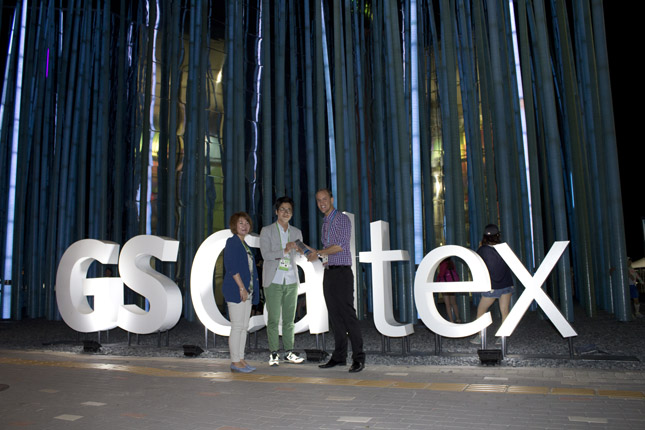 BEST EXTERIOR DESIGN
Winner:
BEST EXTERIOR DESIGN
Winner: GS Caltex Pavilion
Client: GS Caltex Corp., Peopleworks Inc.
Design: Atelier Bruckner GmbH
Fabrication: S.H.G enc; HP&P Hankuk Polymates & Putrision Co. Ltd.
Forests have always been enchanted. From the Black Forest in “Hansel and Gretel” to the Fangorn of “Lord of the Rings,” the woods shimmer with dark spells and diabolic charms. There were no spooky shrubs or fiendish flora in GS Caltex Corp.’s pavilion, but there was a blazing magic as potent as anything the Brothers Grimm or J.R.R. Tolkien ever conjured. As one judge put it, “It was so smartly and immaculately executed that it seems revolutionary.”
Founded in 1967 and based in the South Korean capital of Seoul, the country’s first private oil company cast its spell over attendees not with sorcery but with science. Surrounding GS Caltex’s 6,430-square-foot edifice was a forest of light that stood out at night among its neighboring pavilions like a bonfire next to a Zippo lighter. Made of 52-foot-tall Fiberglas poles, the 380 stalks represented a metaphor for energy itself, and its ultimate source, the sun. Meant to suggest stalks of rice — which account for 90 percent of Korea’s total grain production — the poles each concealed color-shifting LEDs. When the sun went down, they began lighting up in 15-minute sequences of amber, turquoise, carmine, and lavender hues as if they had been absorbing energy from the midday sun — but not the familiar yellow ball of hydrogen and helium 93 million miles distant, rather GS Caltex’s star-shaped structure at the center of the forest, clad in mirrors and featuring a logo-adorned rooftop space.
Visitors wandered between the swaying shafts — the 243-pound poles were designed to bend in a typhoon, and could sway up to 23 feet without snapping — where they could press buttons on several of the undulating stalks. Once pressed, the buttons activated a five-minute interactive sequence: Pulses of light fanned out in the shape of shock waves over the dense thicket of poles. “We wanted the design to create a never-ending moment for visitors,” said Linda Greci of Atelier Brückner GmbH, the Stuttgart, Germany-based company that designed the pavilion. “We did it with the poles’ continuous motion that symbolized the never-ending flow of energy in nature.”
The message the company conveyed was as simple as a sunbeam: The future of energy is in your hands. With an exterior that existed somewhere between the forest of Snow White and the Los Angeles of “Blade Runner,” GS Caltex found its place in the sun.
Honorable Mention: Theme Pavilion
Client: Organizing Committee, Expo 2012
Design: Soma ZT GmbH
Fabrication: Hyundai Construction

Resembling a great white shark ripping through the water, the Theme Pavilion seemed more biological than building. While one side of its exterior was peppered with triangular windows, the other was modeled after lamellas, the thin membrane that helps form layers of bone in sea-faring creatures. Built from glass-fiber-reinforced polymers, the scale-like “skin” was inspired by biomimetic research conducted by Knippers Helbig Advanced Engineering and the ITKE Institute at the University of Stuttgart. Based on naturally occurring “elastic deformation” processes seen in plant life, the flexible, kinetic “skin” could open or close, revealing gill-like gaps to naturally ventilate the pavilion. Further reducing the structure’s carbon footprint, roof-mounted photovoltaic panels generated solar power, and sea-water heat exchangers provided a renewable heating and cooling source.
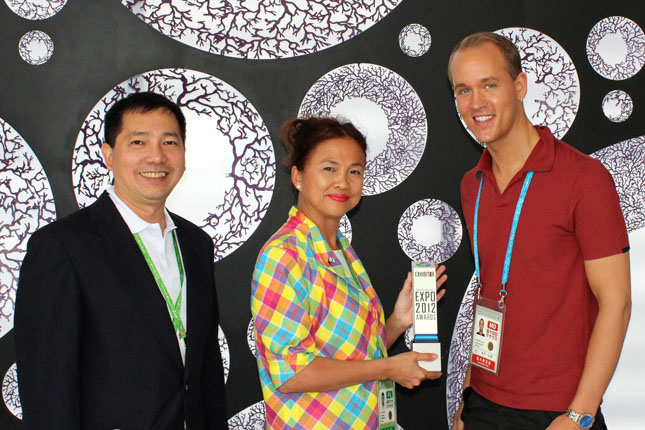 BEST EXHIBIT/SMALL PAVILION
Winner:
BEST EXHIBIT/SMALL PAVILION
Winner: Philippines Pavilion
Client: Philippine Organizing Committee
Design: U26 Design Studio
Fabrication: Pico North Asia Ltd.
The Philippines Pavilion lured visitors with a delightful deception. From a distance, white bubbles dotting the structure’s black exterior mimicked the domino-like spotting of the butanding, the massive 20-ton whale shark and eco-tourism attraction in the Philippines. But if attendees stood closer to the lacy black and white circles, the spots morphed into a stylized panoramic depiction of the country’s more than 3,500 square miles of coral reef made of wrought iron by Korean and Filipino artists.
Inside the 843-square-foot pavilion, four ornate pods suspended from the ceiling represented the corals that form a submerged border around the country’s 7,100 islands. The 20-foot-tall pods were made of intricate wrought iron, similar to the heavy-metal artwork on the outside of the pavilion. LEDs inside the 660-pound pods cycled through colors that mimicked the kaleidoscopic hues of coral. On the floor beneath each of the four pods was a circular enclosure. Three of the enclosures were dedicated to the Philippines’ main island groups — Luzon, Visayas, and Mindanao — while the fourth focused on the country’s conservation efforts. The rims around the island-centric rings were filled with sand from that particular
region’s beaches. Guests were invited to get hands on with the sands, exploring the powdery softness of some and the grainy abrasion of others. Screens on the floor of each circular pod ran video clips promoting that island group, its conservation efforts, and eco-tourism highlights.
On one wall, a projection screen offered an animated tour through the Philippines’ vast wealth of marine life, including the butanding, whose “Jaws”-meets-”Jurassic Park” bulk belies its dependence on a fragile ecosystem. On the opposite wall, nearly 100 bowl-like sculptures made of abaca, a twine-like textile derived from a banana tree indigenous to the country, formed an impressionistic map of the Philippines’ islands. A model of diminutive elegance, the pavilion was a testimony to the idea that size is not always eminence, and that small can indeed be beautiful.
Honorable Mention: Lithuania Pavilion
Client: Ministry of Environment of the Republic of Lithuania
Design: Klasikinis Portikaas Ltd; Pico North Asia Ltd.
Fabrication: Pico North Asia Ltd.
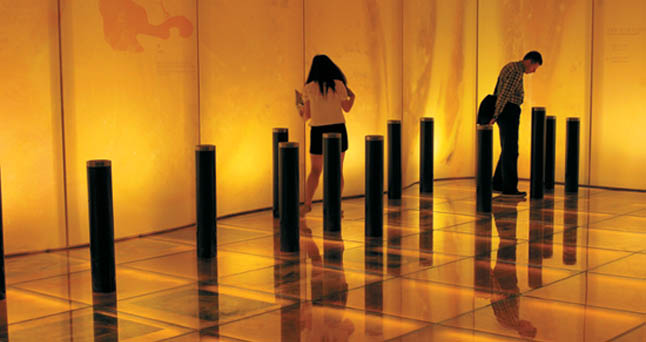
Physicists say the concept of time travel breaks all the known laws of nature and is therefore impossible. But Lithuania proved a mere colored gemstone is a time machine invented by nature itself. The walls, floor, and ceiling of the Baltic republic’s pavilion glowed in the shade of “Lithuanian gold,” the amber the country is famed for. Black steel tubes shot up from the floor like polished stalagmites, with steel tips that contained chunks of amber older than dinosaurs. Approximately 20 floor tiles were imprinted with photos of ancient life perfectly preserved in the fossilized resin. The immersive design was meant to give visitors a bug’s eye view, so to speak, as if they, too, had been trapped in a bead of amber. Just as the resiny substance did insects in a world lost long, long ago, the arresting and awe-inspiring Lithuanian pavilion enveloped attendees and stopped them dead in their tracks.
 BEST ACTIVITY/INTERACTIVE
Winner:
BEST ACTIVITY/INTERACTIVE
Winner: Singapore Pavilion – “Water Harvesting”
Client: Ministry of the Environment and Water Resources, Republic of Singapore
Design/Fabrication: Pico Art International Pte. Ltd.
In Singapore, water is more valuable than gold. Even though the Asian country is the second-most densely populated nation on Earth, Singapore possesses no fresh-water drinking supplies of its own. Perhaps, then, it is no surprise Singapore won the Expo 2012 Award’s Best Activity/Interactive category for inviting attendees to harvest water and meditate on each drop’s inherent value.
After being guided through the 7,664-square-foot
pavilion, attendees paused before a steep staircase. Above them, the climatic combat of a tropical rainstorm — a source of life Singapore must capture and recycle constantly to survive — raged on a projection screen. Both sides of the staircase’s backlit curvilinear walls were lined with hundreds of pieces of a traditional handmade Korean paper called “hanji.” Visitors were asked to pluck one of the fragile sheets from the walls. With the paper in hand, they descended the stairwell into a glowing gallery space. Before exploring the rest of the area, guests were invited to write their thoughts or hopes for the future on their hanji, which was then stamped with blue or red ink.
Next, participants walked along a series of long mesh-like trays lining the wall. Drops of water drizzled slowly through the trays, sparkling like diamond chips thanks to overhead lighting effects. Canted forward at a slight angle, the trays released the water dripping on them with excruciating slowness, a deliberately sluggish pace that implied the difficulty of trapping enough water for the country of 5.3 million to survive.
Guests harvested the water by holding their delicate slips beneath the trays, which reluctantly gave up a drop of the chemical weave of hydrogen and oxygen. When the water finally hit, the ink on the paper burst and rippled across its surface, creating a one-of-a-kind inkblot of sorts, underscoring the importance and uniqueness of every single action — and every single droplet. “The physical nature of this activity crossed all language barriers to communicate that common message in a simple corridor that other designers may have left blank,” judges said.
Before exiting the Singapore Pavilion, visitors hung their strips of hanji paper on a wall where they would join thousands of others beneath a message in Korean and English that read, “Let’s play our part for a better tomorrow. A sustainable Singapore. A sustainable world.”
Honorable Mention: Germany Pavilion – “Interactive Beach Chairs”
Client: Federal Ministry of Economics and Technology, Germany
Design: Arge Expo 2012: Facts and Fiction GmbH, GTP Architekten
Fabrication: Holtmann GmbH + Co. KG

Scattered across a simulated seaside inside the Germany Pavilion was a series of blue-and-white-striped beach chairs, each with an embedded monitor and a separate control panel. Under intelligent lighting that felt like a baking sun, and a breeze that in turn chilled the torrid thermals, attendees checked out an assortment of topics on the monitors relating to coastlines, such as environmentally friendly ships or tsunami early-warning systems. At one of the interactive beach chairs, guests ran their fingers over a “book” that was actually just a stark-white, book-shaped projection surface. A page-turning motion, however, triggered the interactive projection to turn the “page” and reveal different content. When visitors finished, they could pose for pictures in a final beach chair set up for such photo ops, a reminder that life, and even learning, can be a day at the beach.
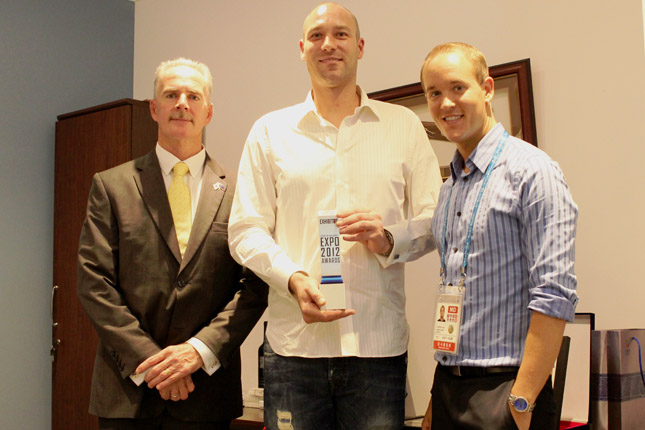 BEST PRESENTATION
Winner:
BEST PRESENTATION
Winner: Australia Pavilion – “Ocean”
Client: Department of Foreign Affairs and Trade, Australia
Design/Fabrication: Think OTS
Up to 180 guests at a time entered the second of the Australia Pavilion’s three main spaces, which housed “Ocean,” a presentation projected onto a pair of abstract metal sculptures. Designed by celebrated Australian sculptor and visual artist Matt Harding, who is known for his supersized, organic-looking art installations, the pair of 39-foot-long sculptures weighed almost 1,500 pounds each. Made of stainless steel and covered in acrylic sheaths, the curious shapes were more cryptic than clear, becoming Rorschach tests for visitors. Guests who gazed upon the appendage-like forms saw in them the outlines of a whale’s tail, a seagull’s body, moose antlers, and other interpretations befitting their inkblot ambiguity.
As the room darkened to a kind of artificial dusk, projection mapping painted the sculptures with 6.5 minutes of epic imagery. But even though visitors stood in the same room within inches of each other, few of them witnessed the exact presentation as their neighbor. Because of the angled screens and their semitransparent qualities, the abstract statuary offered as many unique presentations as there were unique vantage points.
One section of the presentation sparkled with the night-sky constellations of the southern hemisphere, charting the aboriginal concept of deities such as Binbeal, god of rainbows, and Bunjil, who willed rivers into existence to slake humanity’s thirst. Another segment showed the aquatic wonders of Australia’s Great Barrier Reef, with the semitransparent acrylic giving the submerged imagery an impossible sense of depth. Portraits of the aurora australis — the meteorological phenomenon also known as the southern lights — were as psychedelic as Jimi Hendrix on LSD. Photography from along the alien-like Australian coastline looked less like it was shot by humans than by the Martian rover, Curiosity. Played out on the sculptures’ bizarre geometries, the presentation was as hypnotic as the sound of the didgeridoo. “‘Ocean’ was simple, artful, mesmerizing, and engaging,” one judge said. “I could have watched it all day.”
Honorable Mention: Lotte Pavilion – “360º Rider Theater”
Client: Lotte Co. Ltd.
Design/Fabrication: Daehong Communications
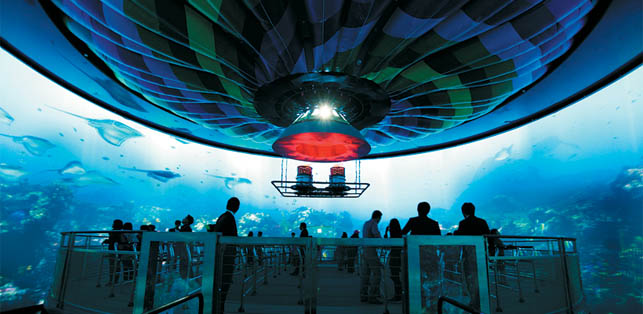
Even at world expos, most 4-D theaters vary little from the been-there-done-that mold: Viewers sit in a group of chairs fixed in an arranged pattern on a floor, which shakes them like a popcorn popper and sprays them with some water. Lotte broke that model with the 360° Rider Theater, which transformed the viewing experience into an immersive hot-air balloon ride. Up to 200 riders at a time strode up a walkway onto a 46-foot-diameter, 13-foot-high, floor-like motion plate that weighed 25 tons. With “flames” (actually red-orange streamers) from a faux burner appearing to funnel heated air into a painted balloon overhead, attendees went up, up, and away. On a 72-by-30-foot screen encircling the room, the balloon soared to heights where eagles would be afraid to dare, then skipped like a rock over ocean waves. Gusts of wind from hidden fans batted the balloon like a kitten with a ball of yarn, ultimately landing attendees in a fictionalized, almost Utopian rendering of the Expo 2012 grounds.
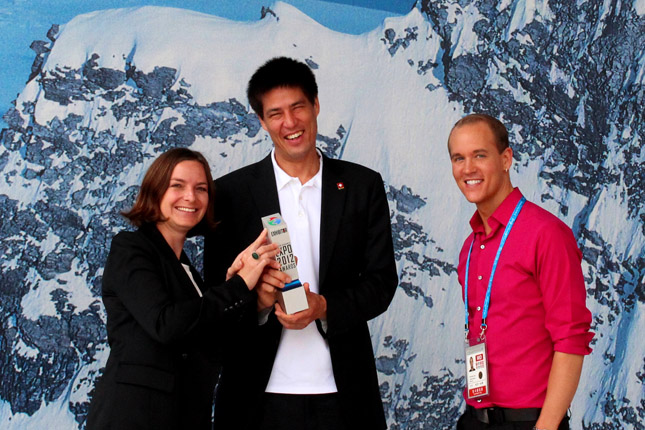 BEST INTERPRETATION OF THEME
Winner:
BEST INTERPRETATION OF THEME
Winner: Switzerland Pavilion – “The Source. It’s in Your Hands.”
Client: Swiss Federal Department of Foreign Affairs
Design: Steiner Saren AG fuer Kommunikation, Switzerland; Tamschick Media+Space GmbH
Fabrication: Neussli AG
Inside its 9,364-square-foot pavilion, Switzerland crafted an experience that integrated sound, sight, and touch to reinforce its water-conserving theme of “The Source. It’s in Your Hands.”
Visitors entered through a circuitous 60-foot-long tunnel where the sound of water droplets plinked down around them as if they were exploring inside one of Switzerland’s many cavernous mountains. Winding their way through the dark passage’s high, narrow, black interior, they passed several areas featuring facts and figures written on the walls, such as “15,500 liters of water are needed to produce one KG of beef meat.”
Instead of just hurling alarming statistics at them like snowballs, the Swiss engaged visitors physically as well as mentally. If they stood atop any one of 15 circular orbs on the tunnel floor near the various sets of stats and cupped their hands, a projection appeared between their joined palms reflecting the message on the nearby wall. In one,
a pair of dragonflies materialized out of empty space, echoing the written message that a thriving population of the double-winged insect reflects a healthy water supply.
The tunnel led to the Glacier Panorama, where a 30-foot-long screen offered a film of Switzerland’s glaciers, which represented its disproportionately large freshwater reserves. After emerging from the vast vistas of the Glacier Panorama, guests huddled in the small Plexiglas-enclosed Ice Core room. Here, in a space kept at 23 degrees Fahrenheit, visitors discovered an ice core extracted from the depths of the Aletsch glacier.
Attendees left the primordial ice for the Source Room,
a circular enclosure whose walls were covered with mirrors positioned at various angles. Four projectors flashed
a four-and-a-half-minute movie on a 30-foot-diameter pool, showing how the fluid that covers 70 percent of the Earth’s surface is a source of joy as well as responsibility.
Filing out of the Source Room, visitors exited the pavilion past a duo of long spigots that dispensed water into translucent bowls. Slaking their thirst with local water that had been treated using Swiss technology, visitors once again repeated the act of cupping their hands, a physical motion that reinforced the “It’s in your hands” message.
Honorable Mention: Germany Pavilion – “Seavolution”
Client: Federal Ministry of Economics and Technology, Germany
Design: Arge Expo 2012: Facts and Fiction GmbH, GTP Architekten
Fabrication: Holtmann GmbH + Co. KG

In addition to developing interesting and engaging themes for its Expo pavilions, Germany has a history of coining clever names for them as well, such as “Balancity” (“balance” plus “city”) for Expo 2010 in China, and now “Seavolution,” for Expo 2012, marrying the words “sea” and “evolution.” Reflecting its conceptual craftsmanship, Germany interpreted its theme in a way that was impish and informative. Robot mascots explained scientific concepts in simple terms to visitors, while displays in various immersive settings supplied reams of data on environmental issues facing the oceans. Presentations on topics as diverse as untapped mineral beds and the dangers of methane bubbles relied on treasure-chest motifs, simulations inspired by 1950s science-fiction movies, and magicians’ tricks from the Victorian era. Even its futuristic animated movie had touches of “20,000 Leagues Under the Sea” and “The Abyss” that informed attendees without drowning them in data.
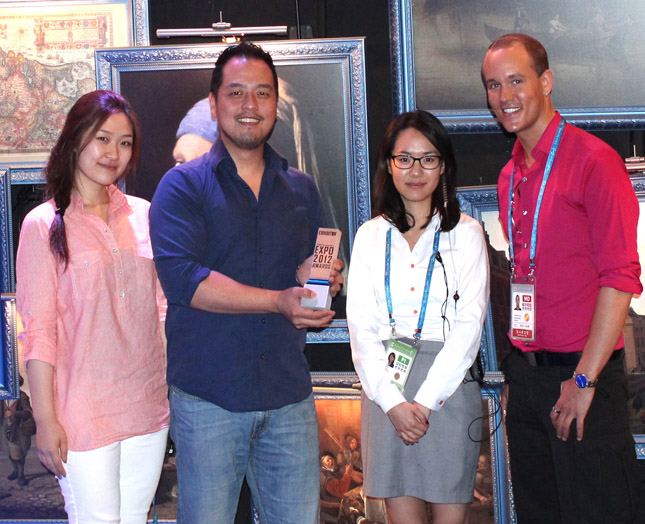 ELEMENTS & DETAILS
Winner:
ELEMENTS & DETAILS
Winner: Netherlands Pavilion – “Audiovisual Map”
Client: Ministry of Economic Affairs
Design: Totems Communication B.V.; Gielissen Interiors & Exhibitions
Fabrication: KBS
“It is not down in any map; true places never are,” wrote Herman Melville. That may have described the vast and mysterious sea in Melville’s “Moby Dick,” but the Netherlands Pavilion boasted a map that transcended mere cartography to chart its country’s true soul. With two-thirds of their land vulnerable to the floods that have nearly washed away the entire country several times over the last millennium, the Dutch know that the encroaching sea is a feral animal that does not like to be restrained. They battle it with dunes, dams, and dikes the way other countries combat their enemies with soldiers, tanks, and airplanes. To demonstrate its precarious balance of power with this implacable foe, the Netherlands created an audiovisual map in its pavilion that transported visitors not only to an area in space but also to a state of mind. “The map transformed art, maps, and landscapes into a spectacular immersive environment,” one judge said.
When attendees walked into the Map Room, it was as
if they were stepping on a giant’s road atlas: The floor had been transformed into a 49-by-115-foot map. In reality,
the chart was a series of projection screens arranged on the surface of the floor like old-fashioned analog maps that resisted proper refolding. Accompanied by the strains of poignant classical music, a three-minute flood of filmed images supplied by Dutch cartographic and water-related organizations washed over the screens: satellite views of a country whose enemy is always at its border; historic images of floods; and windmills, bridges, and beaches, all showing a country as defined by water as Saudi Arabia is by sand or Tibet by mountains.
Lending ever more of a visceral reality to the experience were two measuring rods. Standing 24 feet high, the rods were actually existing hall columns clad with graphic panels showing how much of a given area is beneath sea level. Commonplace throughout the Dutch landscape, the measuring rods were stark reminders of daily life in a country where 21 percent of its population is located below the level of surrounding oceans.
To truly discover another country, you need more than a geographic sketch of distances and borders. With its audiovisual map, the Netherlands handed attendees the key to unlocking its soul.
Honorable Mention: Belgium Pavilion – “Culture Carousel”
Client: Belgium
Design: Totems Communication B.V.
Fabrication: Gielissen Interiors & Exhibitions
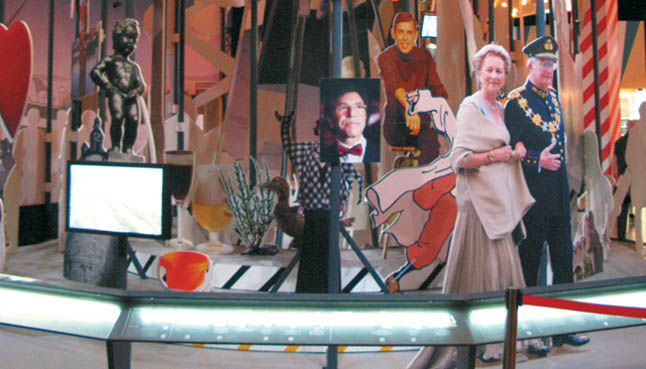
Resembling old-fashioned fairs along its North Sea coast, Belgium welcomed visitors to its Expo 2012 pavilion through a ticket-booth-like entrance leading to an interior dominated by a trio of carousels flourishing the country’s famed products. Diamond-shaped kiosks on one spinning stand held a collection of the precious gems, a reminder that 70 percent of the world’s diamonds pass through the Belgian city of Antwerp. A second carousel displayed an assemblage of photographs and cardboard cutouts of the country’s icons, from waffles and Smurfs to royalty and Tintin. In the third and last carousel, a master chocolatier molded the confection into scrumptious sculptures of plants, porpoises, and more. The handrails circling the spinning stands brandished detailed infographics on all the industrial and cultural products represented, proving Belgium was indeed a carnival where you could find anything from the serious to the surreal.
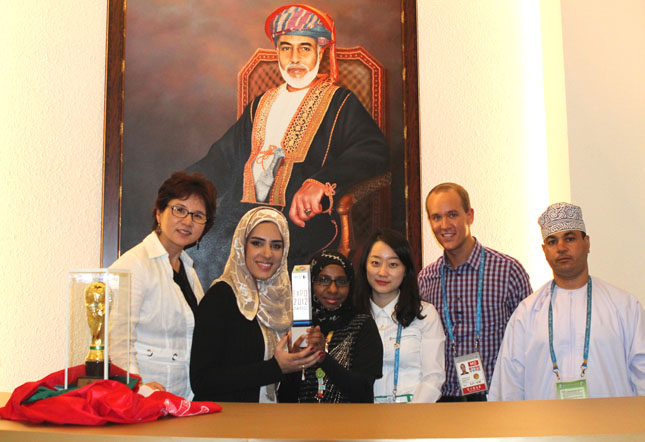 EDITOR’S CHOICE
Winner:
EDITOR’S CHOICE
Winner: Oman Pavilion
Client: Oman Ministry of Commerce and Industry
Design/Fabrication: Cityneon Holdings Ltd.
The moment visitors stepped inside the 6,114-square-foot Oman Pavilion, the piercing perfume of frankincense — a smell that would have been familiar to Oman’s legendary sailor, Sinbad — wrapped around them like a shawl of aromatic smoke. As storied as Oman’s history is, however, its monarch wanted to show the world at Expo 2012 that its maritime present features a 21st century commitment to protecting marine ecosystems and nurturing biodiversity.
Thus, the pavilion wove together the glories of its past with the promise of its future so seamlessly that it won the Expo 2012 Editor’s Choice Award. “More than any other pavilion, Oman managed to take visitors on an epic journey spanning generations and geography,” said Travis Stanton, editor of EXHIBITOR.
In the pavilion’s first segment, visitors followed the fate of five tortoises tagged with radio transmitters through a live satellite feed on Internet-linked video terminals. A virtual aquarium close to the terminals allowed attendees to interact on a trio of monitors with a total of nine digitalized marine species that frequent Omani waters.
From that technological present, visitors segued into the classical past in a section dubbed Historic Oman. While artisans clad in traditional garb carved models of ancient ships by hand, visitors climbed aboard a partial recreation of the Omani Ganjah, a ship that navigated the oceans when the Vikings were just putting their oars in the water. The ancient ship underscored how Oman’s past reached across the gulf of centuries to influence its present.
Next, attendees entered the Nurturing Marine Wealth Through Research & Understanding segment, where sprouting seeds of mangrove trees were arranged in elegant Lucite display cases. The upscale settings implied the mangrove trees’ value to Oman.
The Oman Pavilion’s last stop, a 44-seat, 4-D theater, tossed passengers like dice and blasted them with puffs of air. The moving chairs seemed to plunge guests under a wondrous sea, where they witnessed Oman’s ambitious construction of artificial reefs.
Honorable Mention: Thailand Pavilion
Client: Department Marine and Coastal Resources, Ministry of Natural Resources
and Environment, Thailand
Design: D103 International Ltd.l Index Creative Village PLC
Fabrication: Design Prox

Drawing 10,000 visitors a day, Thailand grabbed attendees’ attention with a mix of the traditional and the technological. Its design inspired by roofs of raft-shaped Thai floating houses, the pavilion’s façade was also highlighted in glittering gold. A stage embedded into one corner of the pavilion housed various presentations in front of a massive LED curtain. There, an animatronic statue of a guardian demon occasionally interacted with an animated film of a boy, Sutsakon, and his dragon-horse companion, Ma Nin Mangkon, who hail from a classic of Thai literature. Inside the pavilion, the playful duo continued their adventure with another animated film, helped by a 15-foot-tall animatronic mermaid. A final film, narrated by the pair, depicted Thailand’s marine resources and its efforts to conserve coastal ecosystems. Ornamented with arrays of gold leaves and reproductions of famed wall frescos, the Thailand Pavilion became a temple of inspired design. And thanks to its exterior stage, LED screen, and animatronic demon, even passersby who chose not to enter got to experience the beauty and culture of Thailand.
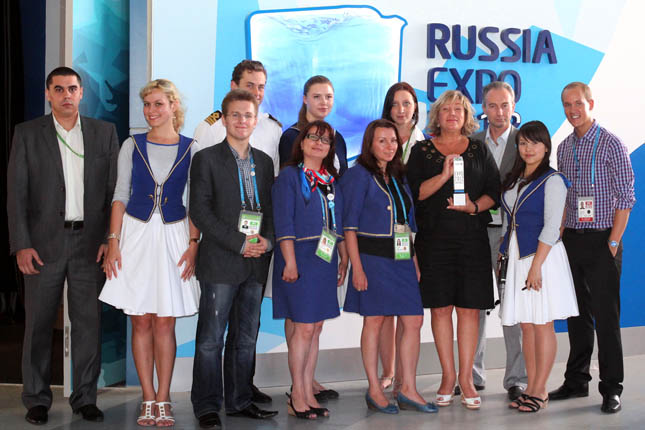 PEOPLE’S CHOICE
Winner:
PEOPLE’S CHOICE
Winner: Russia Pavilion
Client: Russia
Design: Center of Effective Technology and Information Systems Co. (CETIS)
Fabrication: General de Producciones y Diseno S.A.
More than 100,000 people visited EXHIBITOR’s Expo 2012 microsite to virtually peruse the pavilions, and the majority agreed that Russia’s ambitious pavilion was worthy of this year’s People’s Choice Award.
The Russians designed their 3,360-square-foot pavilion in the style of a sequential path that research showed Asian cultures preferred. Following a brief welcome video in the pavilion’s holding area, attendees began their trek in the Ice Tunnel, an elongated igloo-like entryway kept at a chilly 50 degrees Fahrenheit. The tunnel emptied into a museum display of Russian icebreakers that transported pioneering explorers for Arctic expeditions. Next, they stepped on board a replica of the Rossiya, a 75,000-horsepower atomic icebreaker that was reportedly the first such ship to ferry tourists to the North Pole. On a curving bench, visitors watched the film “Arctic Through Time and Space,” which highlighted the region’s vulnerability to man and nature. Disembarking from the Rossiya, attendees moved to the prow of another nuclear-powered icebreaker, where they not only watched, but felt, the ship cut like a knife through a block of solid ice.
In the Knowledge Zone, volumes of digitalized info on the Arctic, Antarctic, oceanic energy, new oceanic technologies, and more were all available on tablet PCs. The self-propelled Mir submersible James Cameron used to film “Titanic” was on display, too, along with models of the new-generation atomic icebreaker. For those who preferred to pilot a ship rather than peruse data about it, a navigational simulator offered the opportunity to play captain of anything from a rescue boat to a transport ship.
Rare photographs from groundbreaking Arctic expeditions provided a time-capsule glimpse of Russian explorers who, over the course of the last 100 years, marched into the bleak and frigid plains. The we-were-here-first explorations gave Russia a more legitimate claim to the Arctic and the vast billions worth of mineral wealth and shipping routes it will offer when its frosty covering eventually melts. Attendees feasting on bellinis and black tea in the pavilion’s restaurant, which was designed to look like a ship’s commissary down to the portholes and steel rivets jutting out of the wall, might have agreed.
Honorable Mention: USA Pavilion
Client: U.S. Department of State
Design: The Hettema Group
Fabrication: Sigong Tech Co. Ltd.
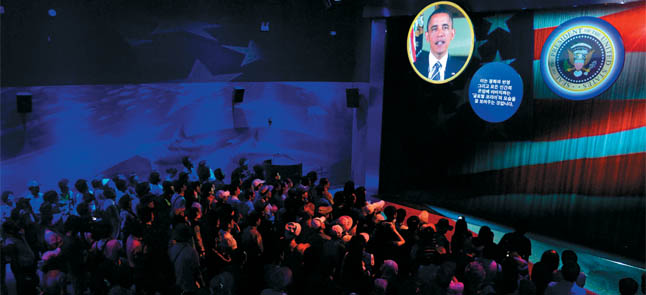
Despite its reliance on corporate funds, the United States’ pavilion was anything but a soulless structure filled with corporate blandishments. Created via a public-private partnership between the U.S. Department of State and a team led by environmentalist and social activist, Philippe Cousteau, Jr. (Jacque Cousteau’s grandson), the 13-312-square-foot pavilion offered as many as 12,000 visitors a day a latte of technology and environmentalism, with a personal, human touch. Visitors entering the pavilion first encountered a large floor-to-ceiling projection screen made of falling water. A literal tie to the ocean-centric Expo 2012 theme, the water screen played a brief tribute to the United States’ diverse coastlines, matched only by the diversity of its people. The movie featured greetings from President Obama, Secretary of State Hillary Clinton, and Cousteau, who expressed concern over our imperiled oceans. The next theater housed a video presentation that explored our 90,000 miles of coastline, with a cross-section of Americans declaring, “This is my ocean.” Running close to 24 minutes, the pavilion experience was as slick as it was sincere, but the real triumph was the staff. Forty bilingual students from 19 states and the District of Columbia served as hosts and guides, as well as unofficial goodwill ambassadors. While most countries kept their efforts within the borders of their pavilions, the United States sent its student ambassadors to speak at Korean schools, clean up littered beaches, and even host a luncheon for children at a resettlement camp for North Korean defectors. To put a twist on a decades-old General Electric Co. ad, when it comes to world expos, people are our most important product.
